Mesoscopic Damage and Fracture Characteristics of Hard Rock under High-Frequency Ultrasonic Vibration Excitation
Abstract
:1. Introduction
2. Materials and Methods
2.1. Experimental Procedures
2.1.1. Sample Preparation
2.1.2. Test Facility
2.2. Test Process
2.3. Extraction Method of Hole and Crack in CT Scanning Image
3. Results
3.1. Microfracture Characteristics of Rock under Ultrasonic Vibration Excitation
3.2. Characteristics of Pore Evolution
4. Discussion
5. Conclusions
- (1)
- Under the stimulation of high-frequency ultrasonic vibration, the maximum crack propagation depth in red sandstone reaches 32.15 mm, with the highest crack development degree in the uppermost rock layer. The total crack length extends to 119.63 mm, and the maximum crack opening value reaches 1.287 mm. The excitation surface edge serves as the crack initiation zone, with the fracture propagating radially towards the free surface, forming a fracture surface. The adjacent fracture surfaces are connected, resulting in local rock failure;
- (2)
- The original CT image’s grayscale interval was equalized, and the image was nonlinearly stretched to enhance the contrast between the matrix and the pores and cracks within the rock. Subsequently, threshold segmentation of the processed image was performed using a trial-and-error method to isolate the pores and cracks in the CT image section. Ultimately, the solid porosity of the red sandstone was determined to be 6.18% when the image segmentation threshold was set at 0.06, which is consistent with the MRI test results;
- (3)
- The application of digital image processing technology was utilized to quantitatively determine the attenuation characteristics of the influence of ultrasonic vibration excitation on rock pore and fracture development with respect to rock depth. The porosity of the CT section in proximity to the excited surface demonstrated a significant increase of 170.42%, whereas that of the lowest CT section experienced a marginal increase of only 0.22%. This suggests a positive exponential relationship between the porosity increment and rock depth;
- (4)
- Incorporating the boundary conditions of the rock during testing, a mechanical model of rock fracture induced by ultrasonic high-frequency vibration, taking into account the effects of static load, is established. The model highlights a significant spatial disparity in the displacement of particles within the rock, with a greater reduction in the maximum displacement amplitude as the distance from the excitation surface increases. As the layer height varies from h to 3/4 h, h/2, and h/4, the displacement amplitudes of rock particles in the corresponding horizons decrease by 0.076, 0.293, and 0.617, respectively.
Author Contributions
Funding
Institutional Review Board Statement
Informed Consent Statement
Data Availability Statement
Acknowledgments
Conflicts of Interest
References
- Huang, X.; Liu, Q.; Shi, K.; Pan, Y.; Liu, J. Application and prospect of hard rock TBM for deep roadway construction in coal mines. Tunn. Undergr. Space Technol. 2018, 73, 105–126. [Google Scholar] [CrossRef]
- Bar-Cohen, Y.; Bao, X.; Chang, Z.; Sherrit, S. An ultrasonic sampler and sensor platform for in-situ astrobiological exploration. In Smart Structures and Materials 2003: Smart Structures and Integrated Systems; SPIE: Bellingham, WA, USA, 2003; Volume 5056, pp. 457–465. [Google Scholar]
- Bagde, M.N.; Petros, V. Fatigue properties of intact sandstone samples subjected to dynamic uniaxial cyclical loading. Int. J. Rock Mech. Min. Sci. 2005, 42, 237–250. [Google Scholar] [CrossRef]
- Sherrit, S.; Chang, Z.; Bar-Cohen, Y.; Badescu, M. Integrated modeling of the ultrasonic/sonic drill/corer: Procedure and analysis results. In Smart Structures and Materials 2005: Smart Structures and Integrated Systems; Jet Propulsion Laboratory, National Aeronautics and Space Administration: Pasadena, CA, USA, 2005; Volume 5764, pp. 312–323. [Google Scholar]
- Feng, J.; Yan, T.; Cao, Y.; Sun, S. Ultrasonic-Assisted Rock-Breaking Technology and Oil and Gas Drilling Applications: A Review. Energies 2022, 15, 8394. [Google Scholar] [CrossRef]
- Wiercigroch, M.; Wojewoda, J.; Krivtsov, A.M. Dynamics of ultrasonic percussive drilling of hard rocks. J. Sound Vib. 2005, 280, 739–757. [Google Scholar] [CrossRef]
- Zhao, D.; Sangesland, S. Dynamical Analysis of Drill Bit With Ultrasonic Vibration. Pet. Technol. 2015, 10, 1–5. [Google Scholar]
- Fernando, P.; Zhang, M.; Pei, Z. Rotary ultrasonic machining of rocks: An experimental investigation. Adv. Mech. Eng. 2018, 10, 1–9. [Google Scholar] [CrossRef]
- Fernando, P.; Pei, Z.; Zhang, M. Mechanistic cutting force model for rotary ultrasonic machining of rocks. Int. J. Adv. Manuf. Technol. 2020, 109, 109–128. [Google Scholar] [CrossRef]
- Zhao, D.; Zhang, S.; Wang, M. Microcrack Growth Properties of Granite under Ultrasonic High-Frequency Excitation. Adv. Civ. Eng. 2019, 2019, 3069029. [Google Scholar] [CrossRef]
- Zhao, D.; Zhang, S.; Zhao, Y.; Wang, M. Experimental study on damage characteristics of granite under ultrasonic vibration load based on infrared thermography. Environ. Earth Sci. 2019, 78, 419. [Google Scholar] [CrossRef]
- Han, J.; Zhao, D.; Zhang, S.; Zhou, Y. Damage Evolution of Granite under Ultrasonic Vibration with Different Amplitudes. Shock Vib. 2022, 2022, 8975797. [Google Scholar] [CrossRef]
- Zhang, L.; Wang, X.; Wang, J.; Yang, Z. Mechanical characteristics and pore evolution of red sandstone under ultrasonic high-frequency vibration excitation. AIP Adv. 2021, 11, 055202. [Google Scholar] [CrossRef]
- Zhou, Y.; Tang, Q.; Zhang, S.; Zhao, D. The Mechanical Properties of Granite under Ultrasonic Vibration. Adv. Civ. Eng. 2019, 2019, 9649165. [Google Scholar] [CrossRef]
- Zhang, L.; Wang, X.; Wang, J.; Yang, Z.; Ma, T. Research on Fracture Characteristics and Energy Dissipation of Hard Rock under the Excitation of Ultrasonic Vibration. Geofluids 2022, 2022, 8351316. [Google Scholar] [CrossRef]
- Zhou, Y.; Zhao, D.; Tang, Q.; Wang, M. Experimental and numerical investigation of the fatigue behaviour and crack evolution mechanism of granite under ultra-high-frequency loading. R. Soc. Open Sci. 2020, 7, 200091. [Google Scholar] [CrossRef] [PubMed]
- Li, S.; Tian, S.; Li, W.; Ling, X.; Kapitaniak, M.; Vaziri, V. Numerical Study on the Elastic Deformation and the Stress Field of Brittle Rocks under Harmonic Dynamic Load. Energies 2020, 13, 851. [Google Scholar] [CrossRef]
- Bieniawski, Z.T.; Bernede, M.J. Suggested methods for determining the uniaxial compressive strength and deformability of rock materials. Int. J. Rock Mech. Min. Sci. Geomech. Abstr. 1979, 16, 138–140. [Google Scholar] [CrossRef]
- Chun, B.; Xiaoyue, L. The edge detection technology of CT image for study the growth of rock crack. In Proceedings of the 2009 ISECS International Colloquium on Computing, Communication, Control, and Management, Sanya, China, 8–9 August 2009; pp. 286–288. [Google Scholar]
- Wang, Y.; Hou, Z.Q.; Hu, Y.Z. In Situ X-Ray Computed Tomography Experiment on Mesodamage Evolution of Subgrade Bimsoil during Cycle Loading. J. Mater. Civ. Eng. 2019, 31, 04019198. [Google Scholar] [CrossRef]
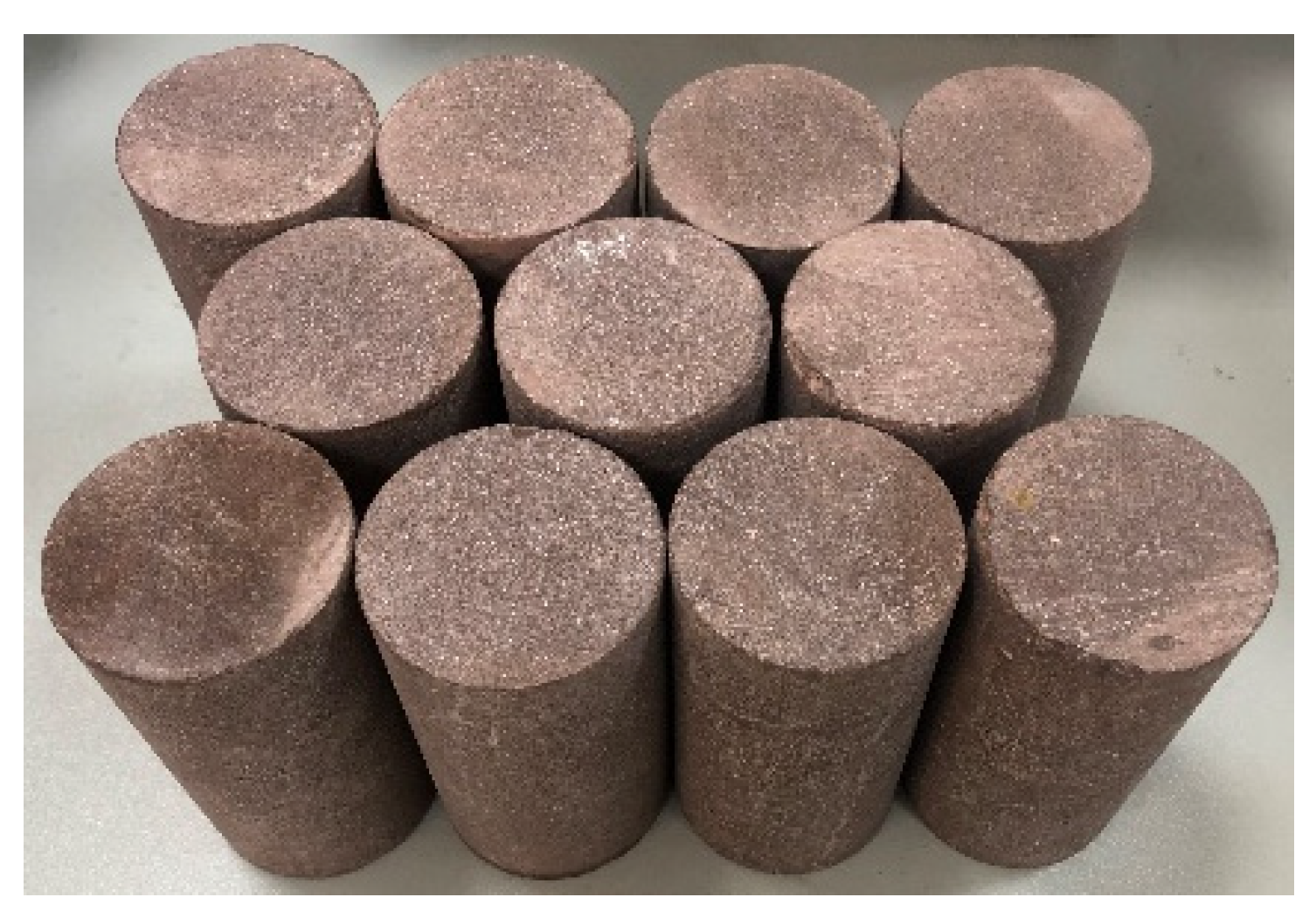
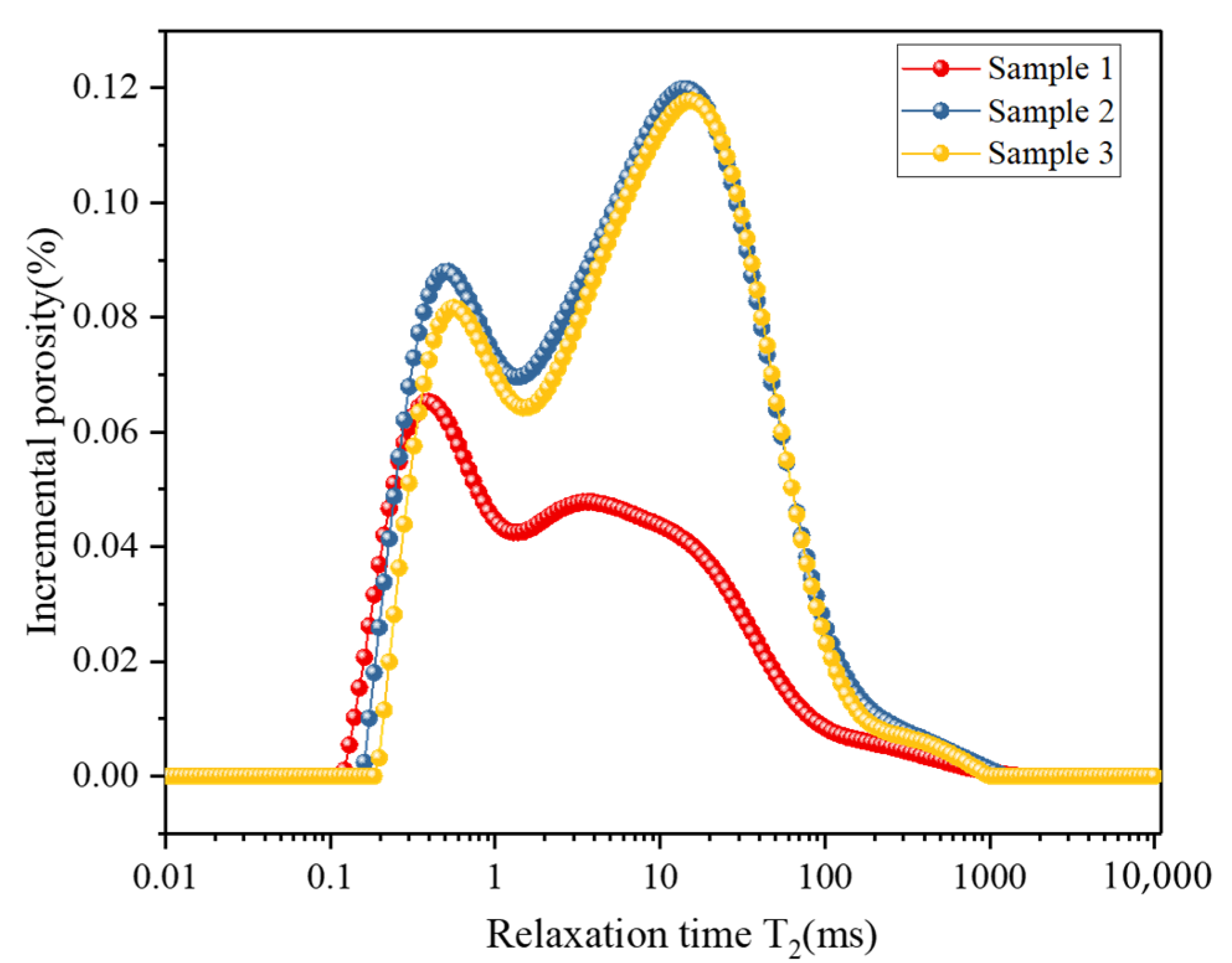
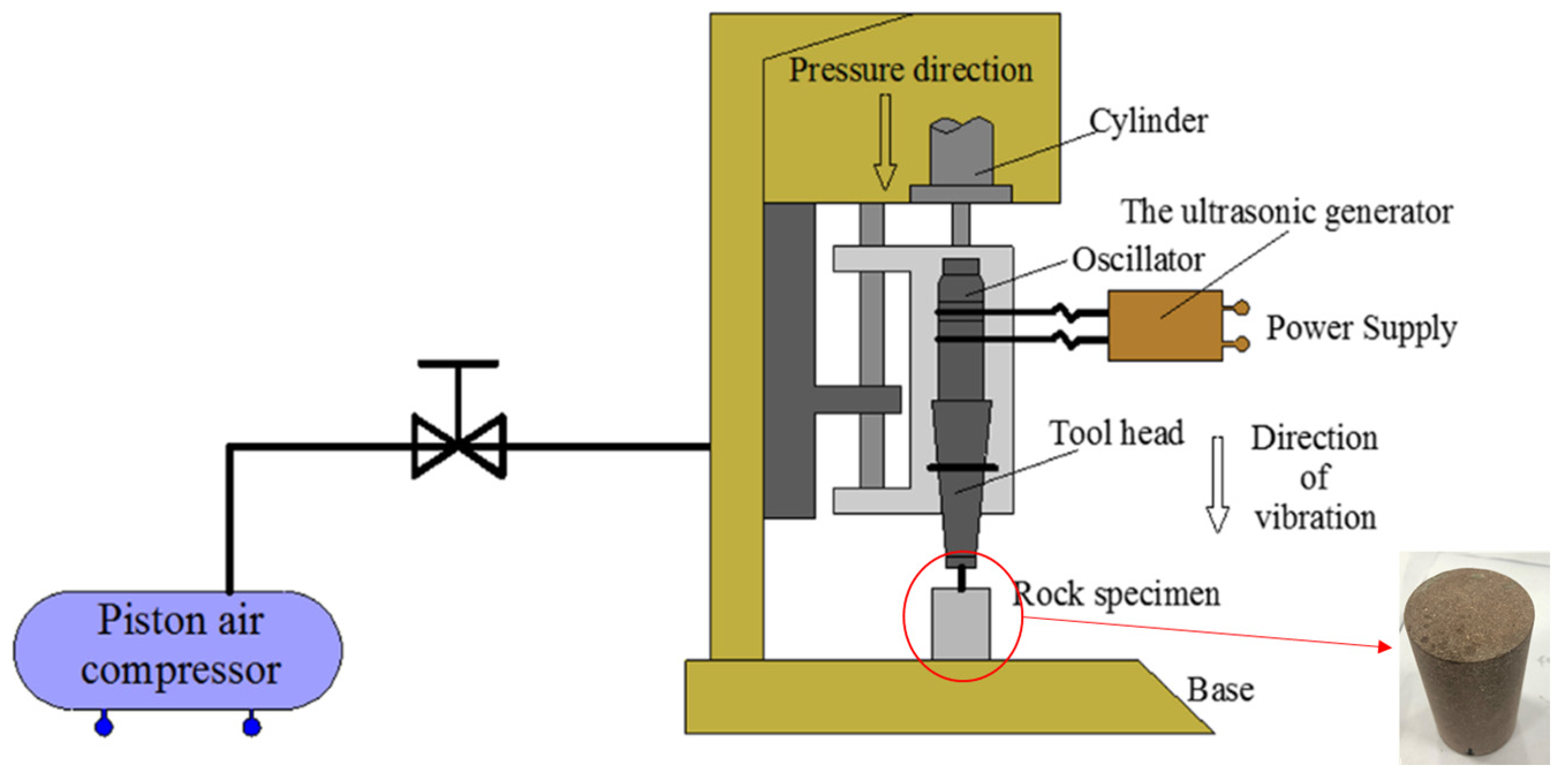
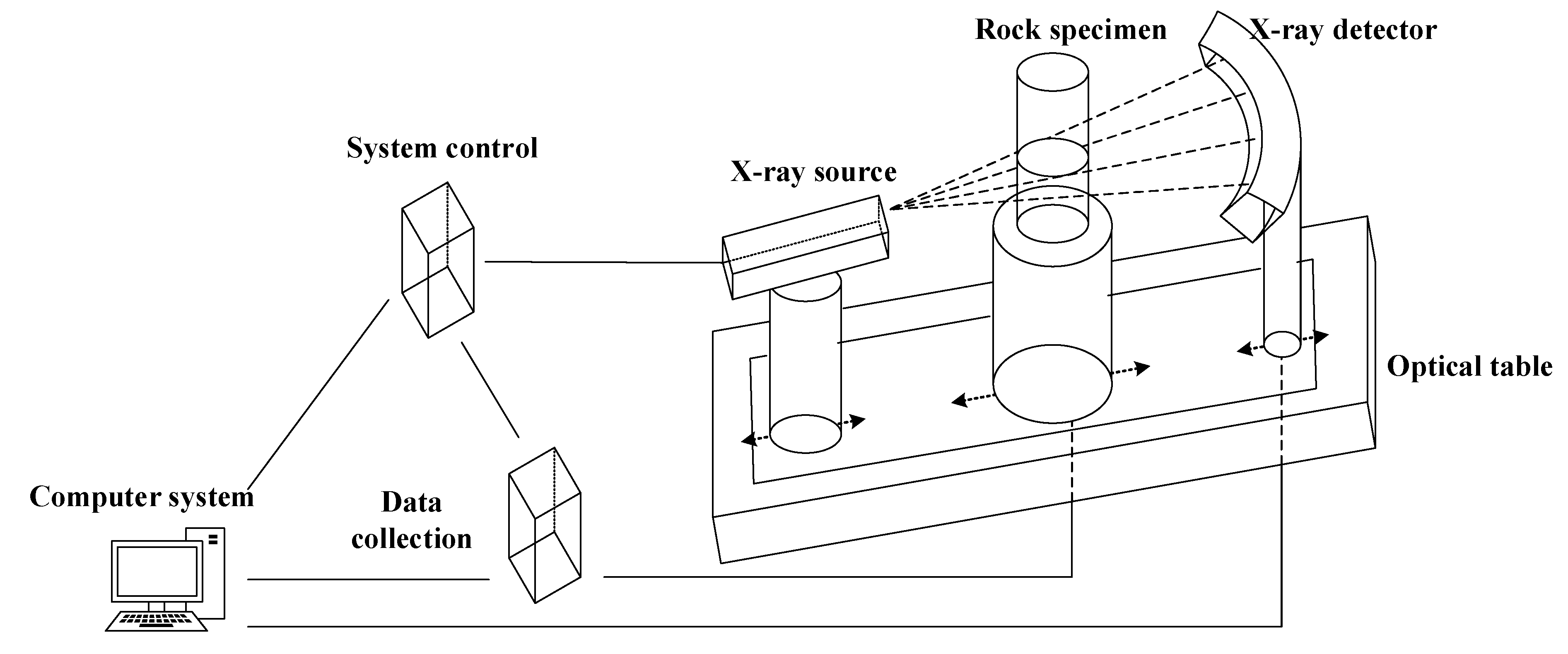

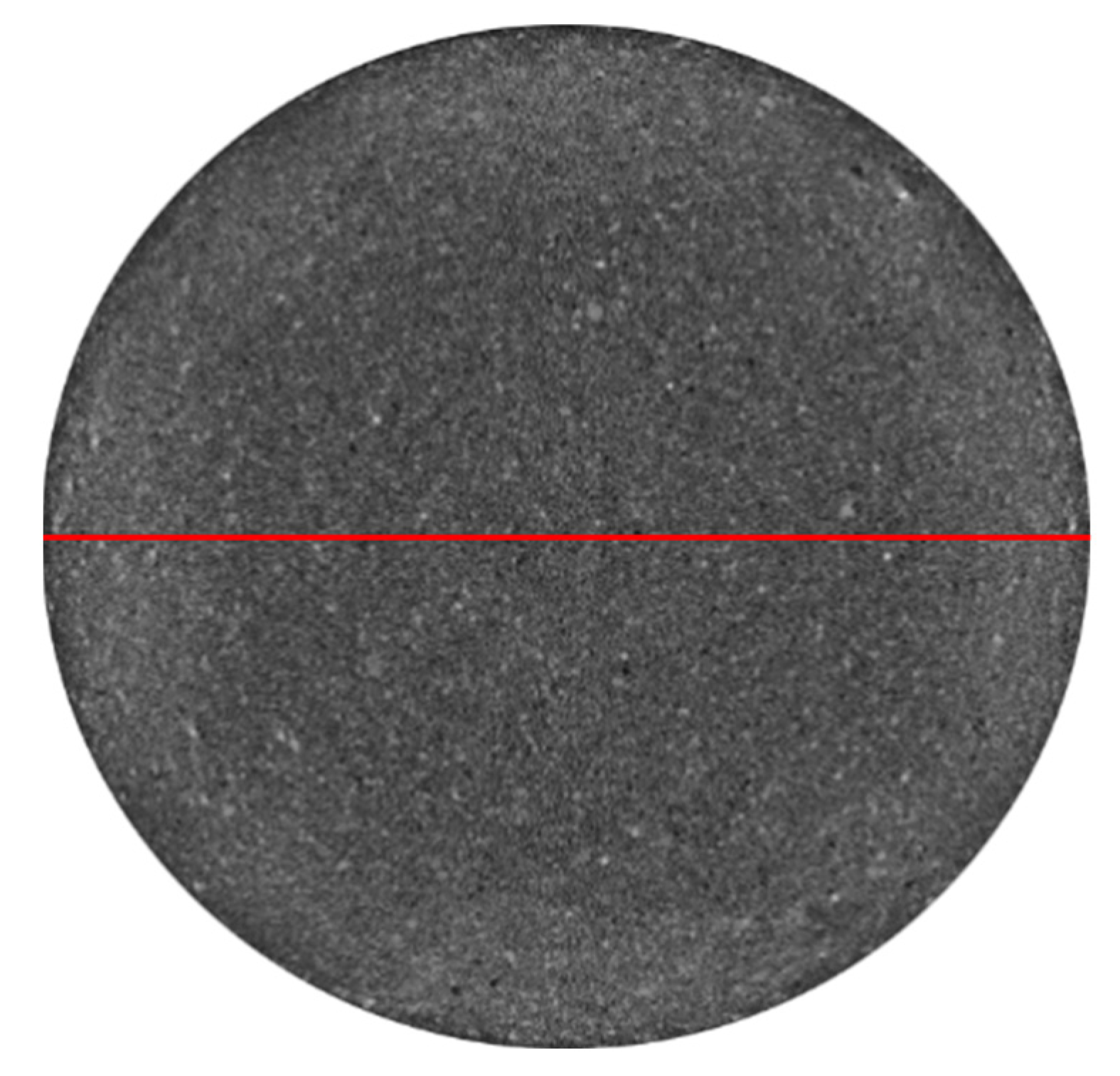

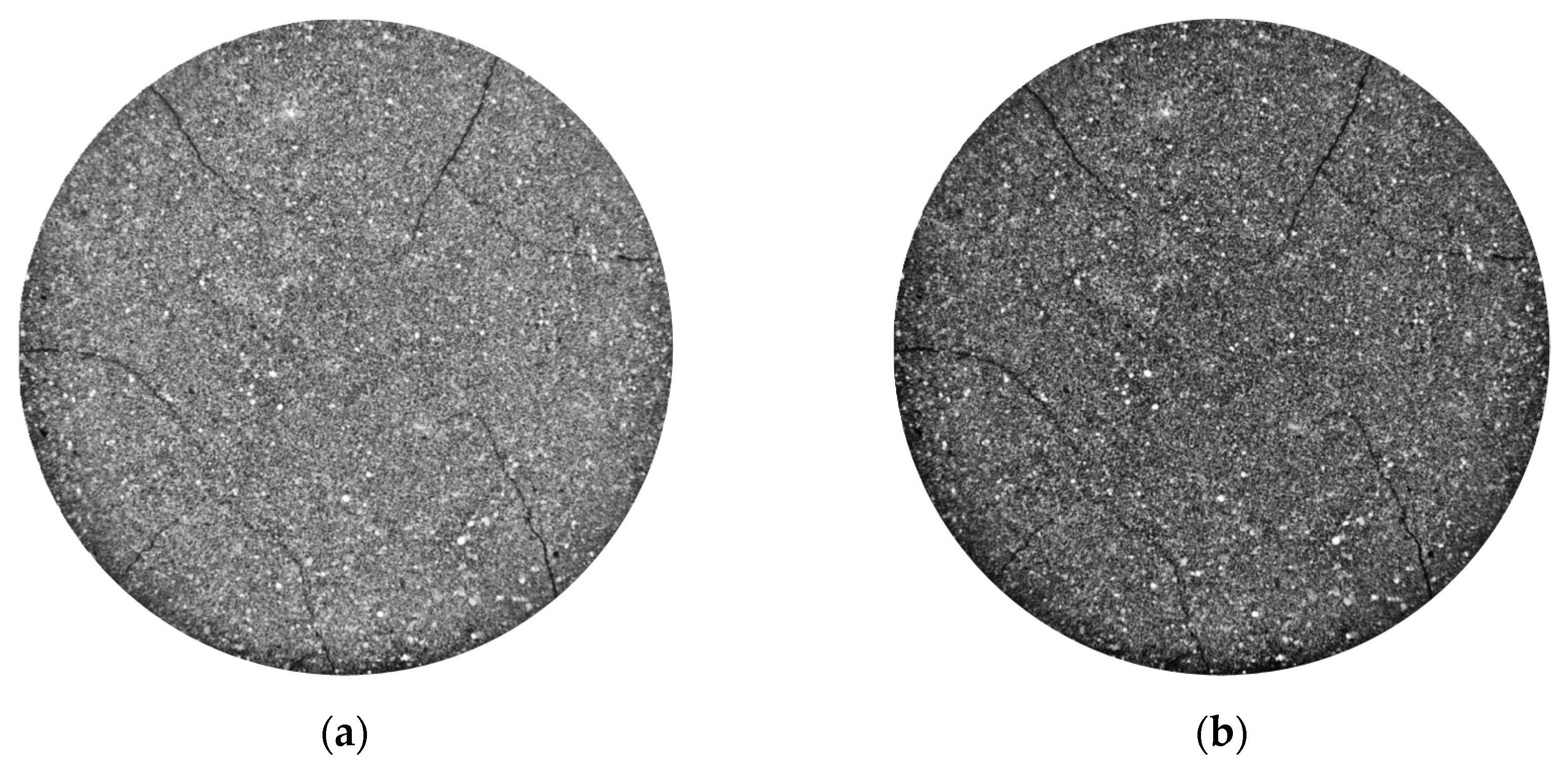
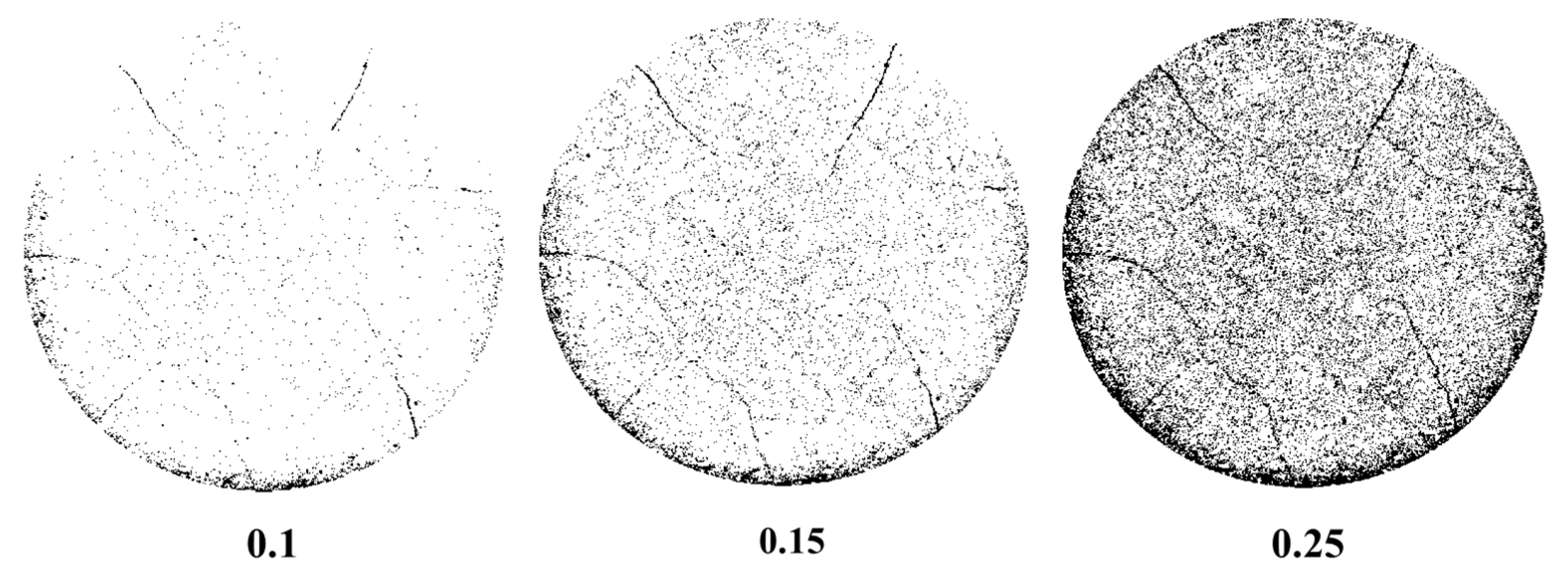

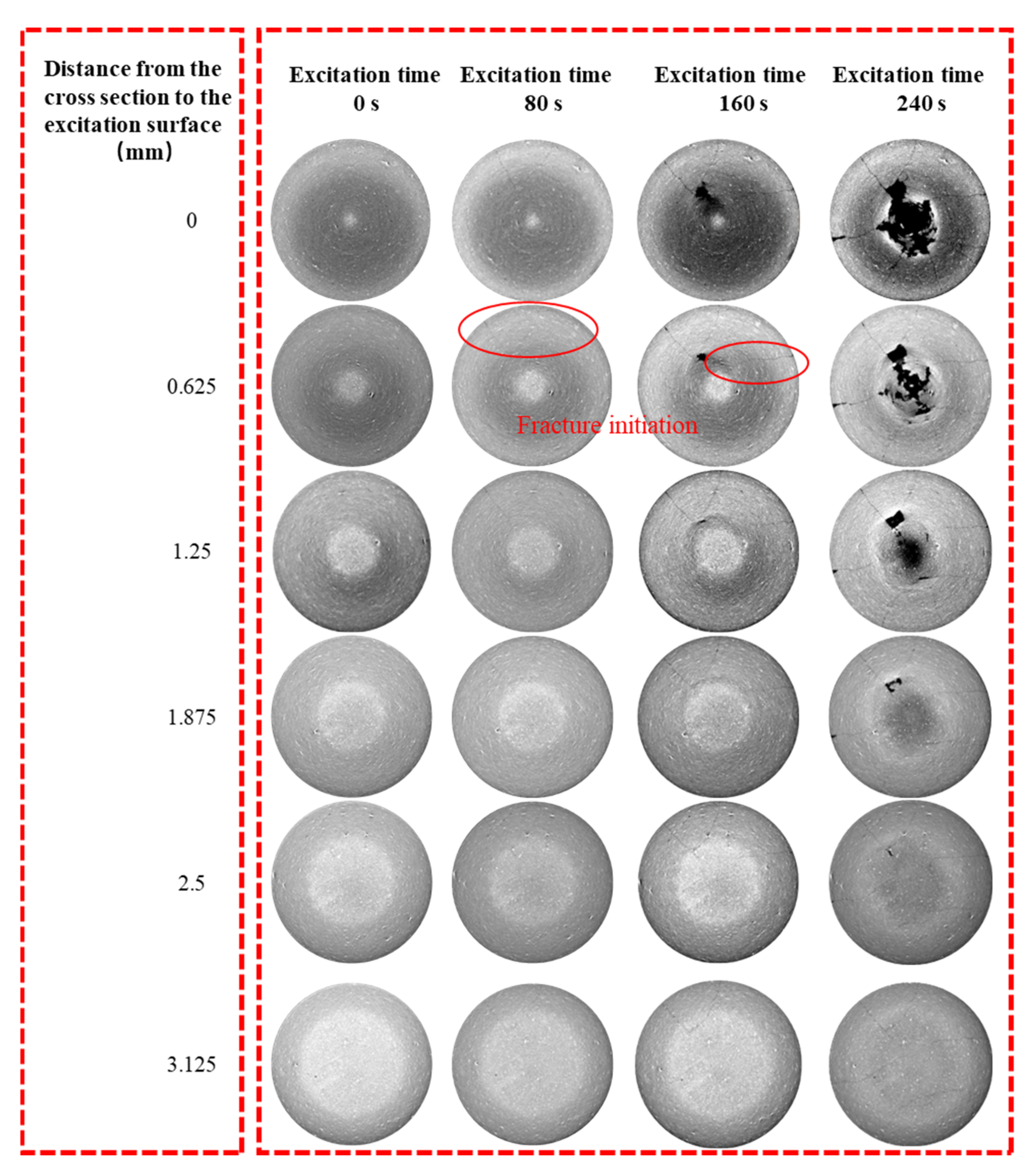
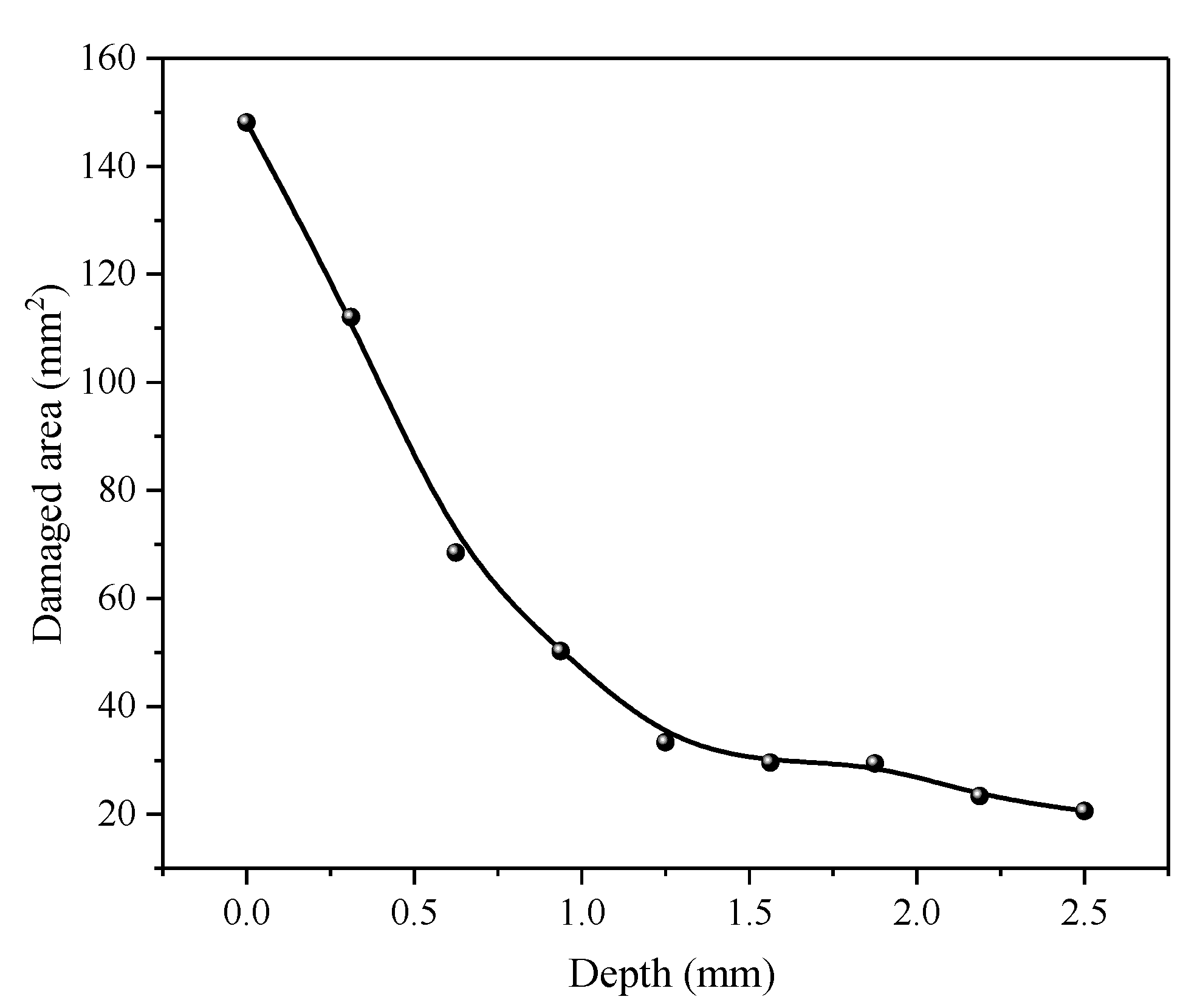
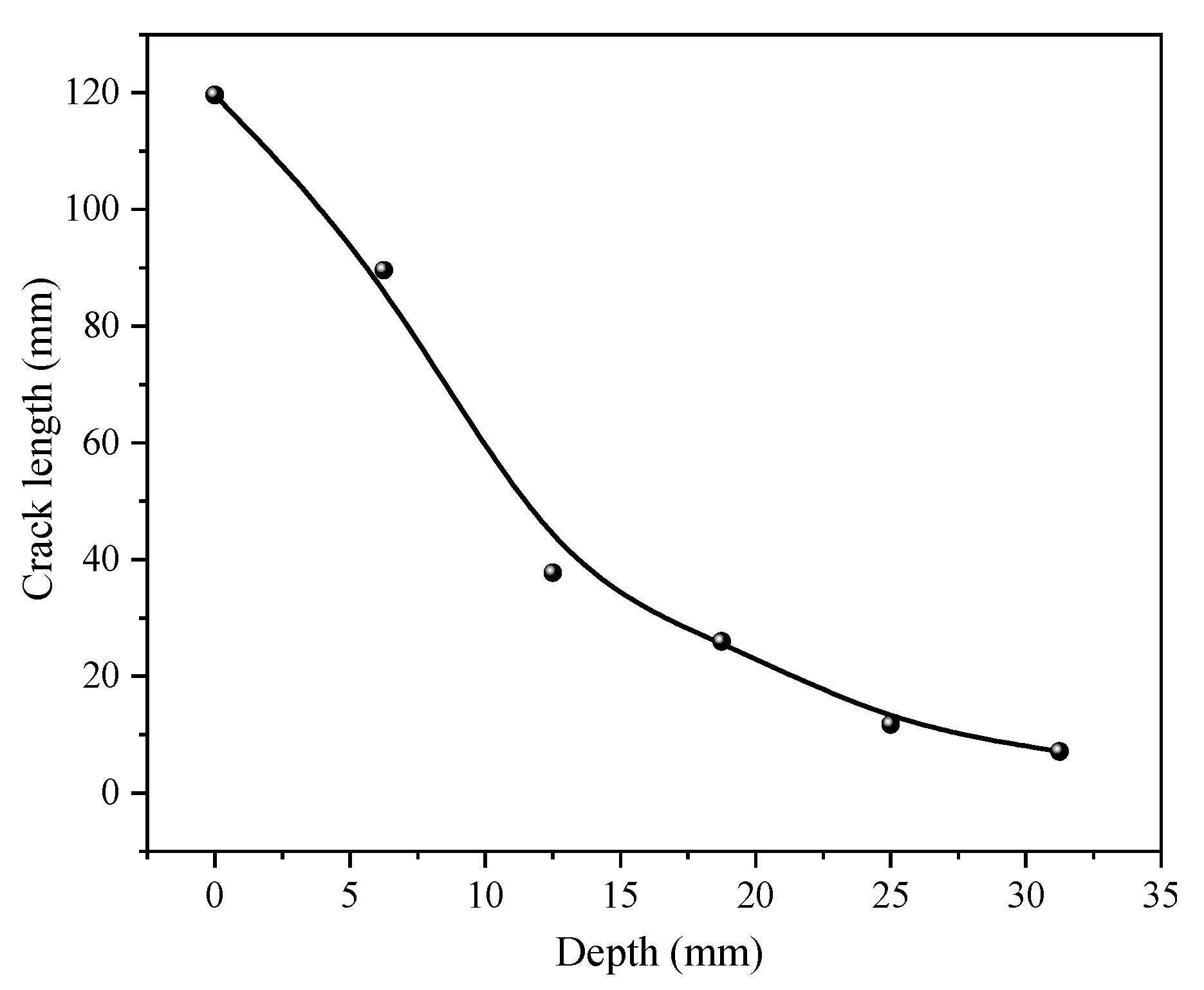

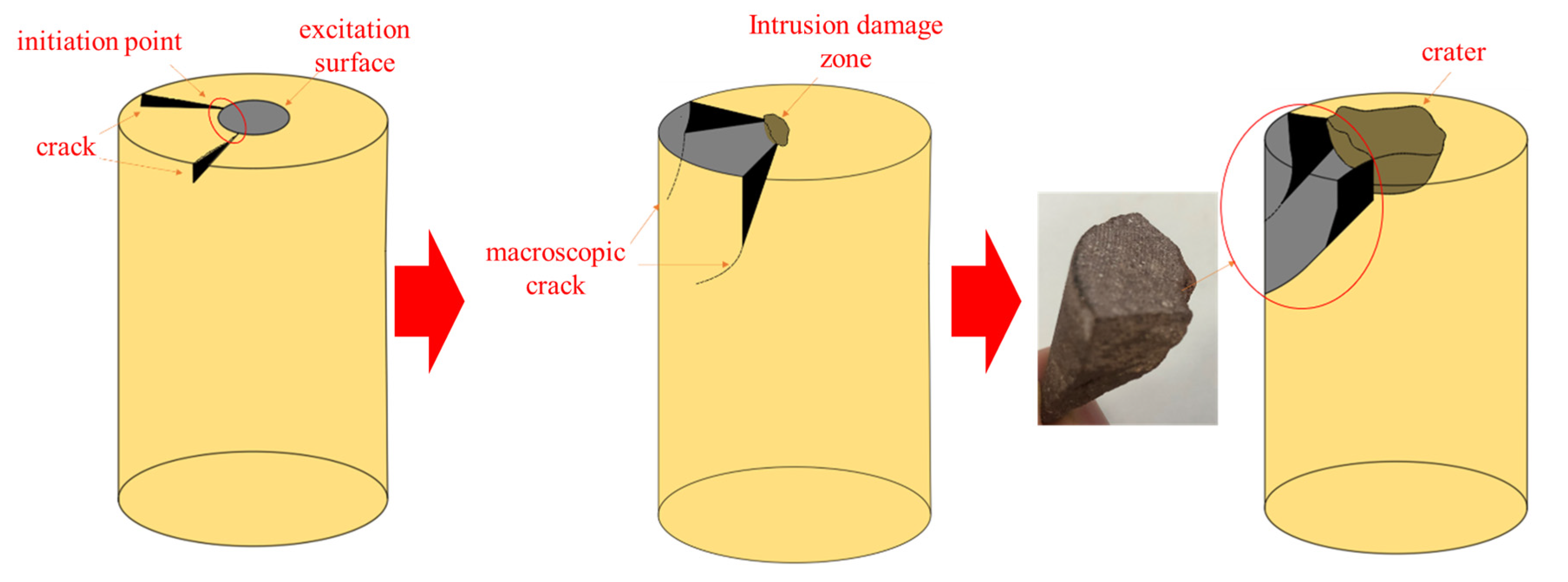

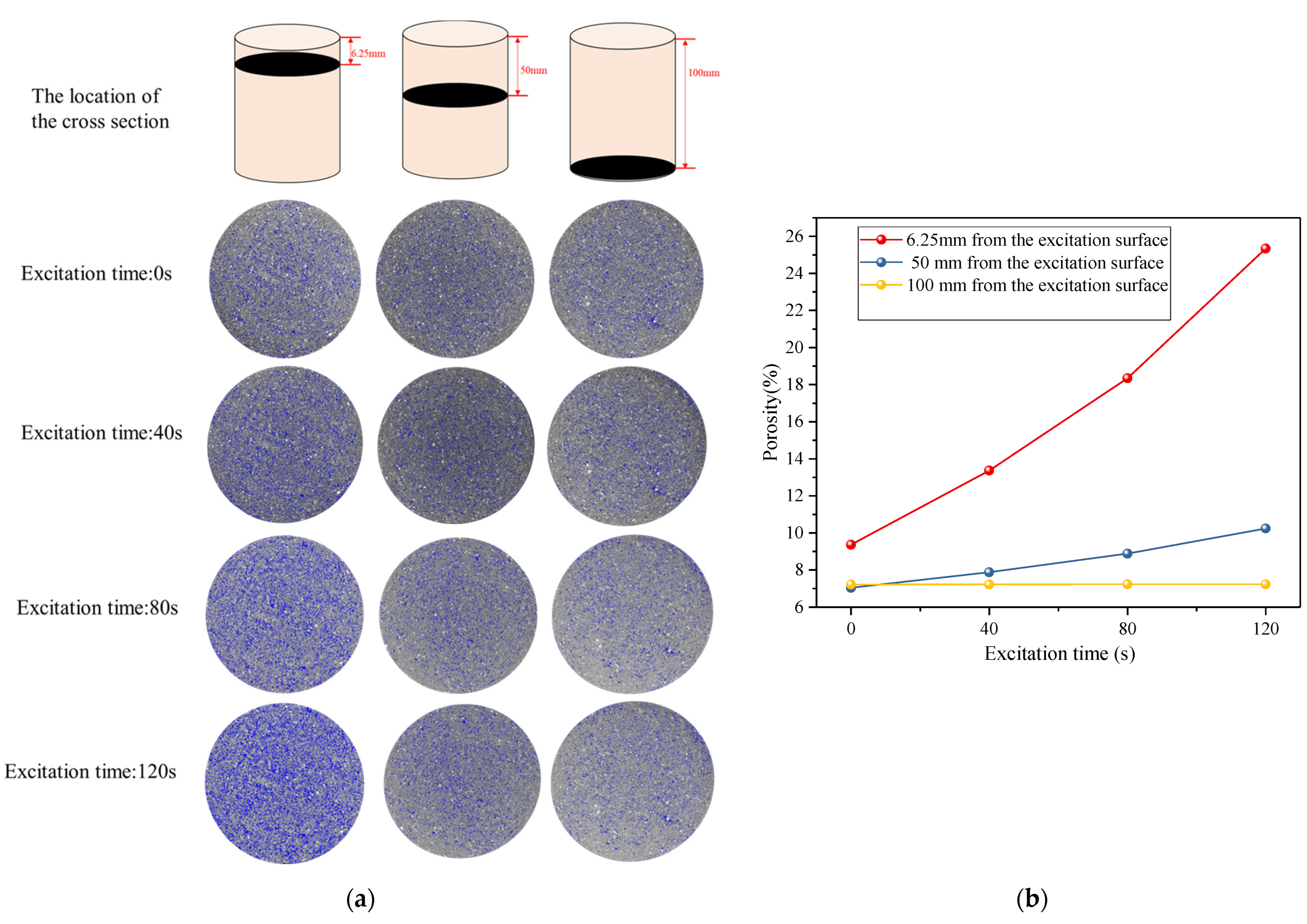

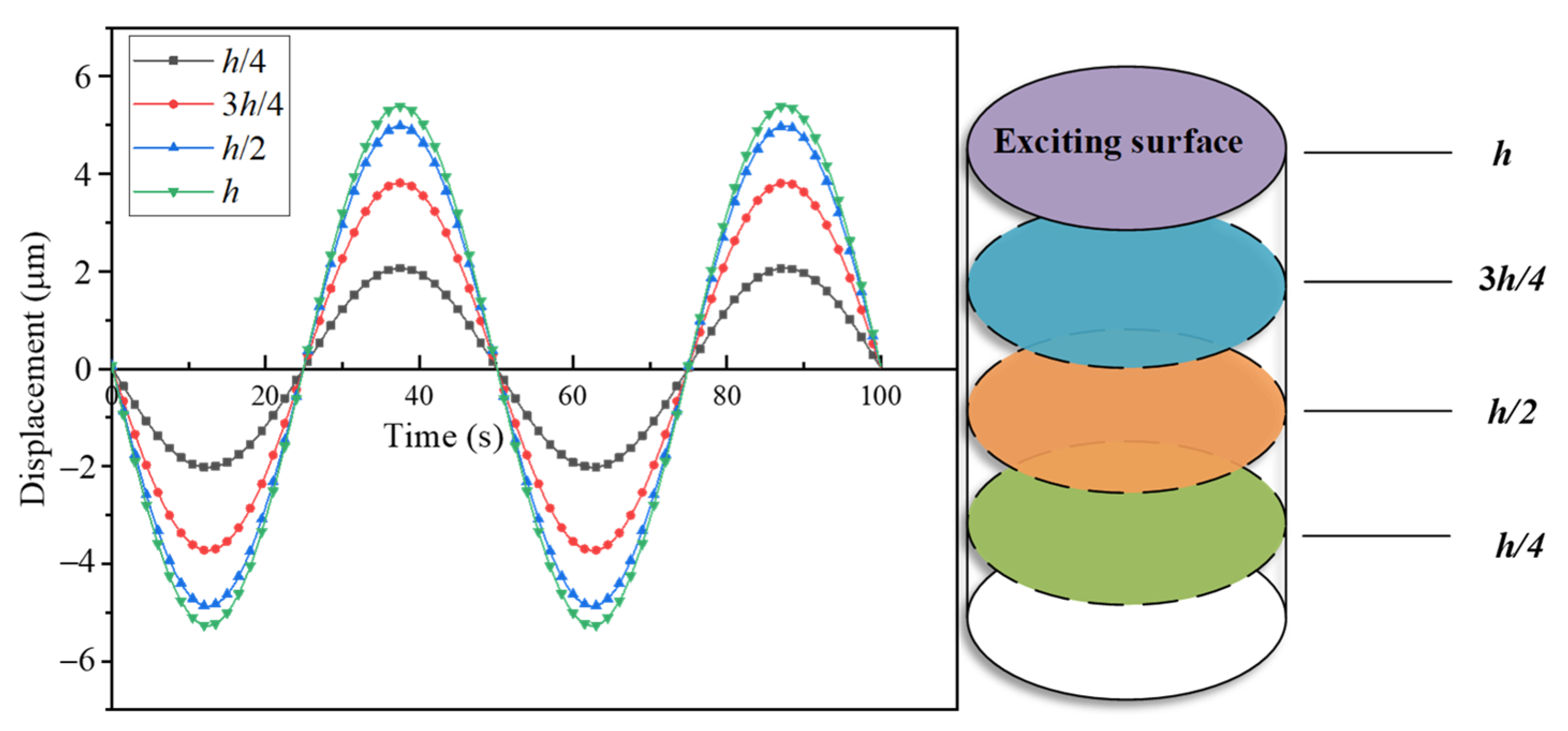
| Power /W | Frequency /kHz | Amplitude /μm | Static Load /MPa | Load Area /mm2 |
|---|---|---|---|---|
| 1500 | 20 | 70 | 0~1 | 176.7 |
| Distance from the Cross-Section to the Excitation Surface (mm) | Porosity(%) | |||
|---|---|---|---|---|
| 0 s | 40 s | 80 s | 120 s | |
| 6.25 | 9.3702 | 13.367 | 18.3494 | 25.3394 |
| 12.5 | 6.443 | 9.9921 | 14.5635 | 19.9725 |
| 18.75 | 4.7949 | 6.5467 | 8.0326 | 14.4786 |
| 25 | 5.8313 | 6.9137 | 8.0256 | 13.5415 |
| 31.25 | 4.3798 | 6.2885 | 7.1535 | 9.9004 |
| 37.5 | 8.3661 | 9.3228 | 11.8708 | 13.3617 |
| 43.75 | 7.0254 | 7.9133 | 8.9723 | 10.435 |
| 50 | 7.0386 | 7.8785 | 8.8883 | 10.2421 |
| 56.25 | 4.1474 | 4.8041 | 6.6219 | 8.2626 |
| 62.5 | 6.7048 | 6.9502 | 7.8743 | 9.1163 |
| 68.75 | 4.8405 | 4.9578 | 5.3178 | 5.8661 |
| 75 | 5.4342 | 5.6875 | 6.0526 | 6.3329 |
| 81.25 | 6.1443 | 6.322 | 6.9952 | 7.2805 |
| 87.5 | 3.8344 | 3.8664 | 3.9032 | 3.9473 |
| 93.75 | 7.2703 | 7.2985 | 7.3963 | 7.4475 |
| 100 | 7.2152 | 7.2235 | 7.2291 | 7.2317 |
Disclaimer/Publisher’s Note: The statements, opinions and data contained in all publications are solely those of the individual author(s) and contributor(s) and not of MDPI and/or the editor(s). MDPI and/or the editor(s) disclaim responsibility for any injury to people or property resulting from any ideas, methods, instructions or products referred to in the content. |
© 2023 by the authors. Licensee MDPI, Basel, Switzerland. This article is an open access article distributed under the terms and conditions of the Creative Commons Attribution (CC BY) license (https://creativecommons.org/licenses/by/4.0/).
Share and Cite
Zhang, L.; Wang, X.; Niu, Z. Mesoscopic Damage and Fracture Characteristics of Hard Rock under High-Frequency Ultrasonic Vibration Excitation. Appl. Sci. 2023, 13, 12424. https://doi.org/10.3390/app132212424
Zhang L, Wang X, Niu Z. Mesoscopic Damage and Fracture Characteristics of Hard Rock under High-Frequency Ultrasonic Vibration Excitation. Applied Sciences. 2023; 13(22):12424. https://doi.org/10.3390/app132212424
Chicago/Turabian StyleZhang, Lei, Xufeng Wang, and Zhijun Niu. 2023. "Mesoscopic Damage and Fracture Characteristics of Hard Rock under High-Frequency Ultrasonic Vibration Excitation" Applied Sciences 13, no. 22: 12424. https://doi.org/10.3390/app132212424






